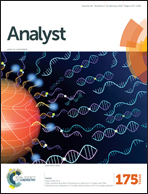Small quinolinium-based enzymatic probes via blue-to-red ratiometric fluorescence†
Abstract
A small fluorescence ratiometric probe consisting of a single dye species, N-methyl-6-hydroxyquinolinium (MHQ), and coupled enzymatic substrates, exhibits a dramatic colour change (deep blue to red) and possesses a huge response ratio (over 2000 fold) upon specific recognition of target enzymes. Such dramatic responses are attributed to the excited-state proton transfer processes of MHQ molecules in water. Here the detection of β-galactosidase and porcine pancreatic lipase is successfully demonstrated and this class of molecules has the potential to be developed as a “naked-eye” probe in vitro.


 Please wait while we load your content...
Please wait while we load your content...